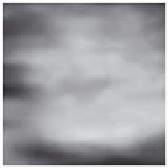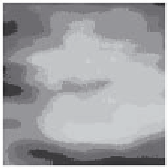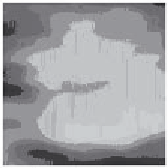Image Processing Reference
In-Depth Information
This is one of the known properties of median filtering: an ability to reduce noise whilst
retaining feature boundaries. Indeed, there have actually been many other approaches to
speckle filtering; the most popular include direct averaging (Shankar, 1986), median filtering,
adaptive (weighted) median filtering (Loupas, 1987) and unsharp masking (Bamber, 1986).
3.5.4
Comparison of statistical operators
The different image filtering operators are shown by way of comparison in Figure
3.25
. All
operators are
5 × 5 and are applied to the earlier ultrasound image, Figure
3.24
(a). Figure
3.25
(a), (b), (c), and (d) are the result of the mean (direct averaging), Gaussian averaging,
median and truncated median, respectively. Each shows a different performance: the mean
operator removes much noise but blurs feature boundaries; Gaussian averaging retains
more features, but shows little advantage over direct averaging (it is not Gaussian-distributed
noise anyway); the median operator retains some noise but with clear feature boundaries;
whereas the truncated median removes more noise, but along with picture detail. Clearly,
the increased size of the truncated median template, by the results in Figures
3.24
(b) and
(c), can offer improved performance. This is to be expected since by increasing the size of
the truncated median template, we are essentially increasing the size of the distribution
from which the mode is found.
(a) Mean
(b) Gaussian average
(c) Median
(d) Truncated median
Figure 3.25
Comparison of filtering operators
As yet, however, we have not yet studied any quantitative means to evaluate this comparison.
We can only perform subjective appraisal of the images in Figure
3.25
. This appraisal has
been phrased in terms of the contrast boundaries perceived in the image, and on the basic
shape that the image presents. Accordingly, better appraisal is based on the use of feature
extraction. Boundaries are the low-level features studied in the next chapter; shape is a
high-level feature studied in Chapter 5.
3.6
Further reading
Many texts cover basic point and group operators in much detail, in particular the introductory
texts such as Fairhurst (Fairhurst, 1988) and Baxes (Baxes, 1994) (which includes more
detail about hardware implementation); other texts give many more examples (Russ, 1995).
Books with a C implementation often concentrate on more basic techniques including low-




















